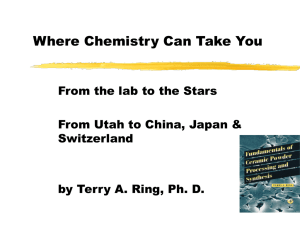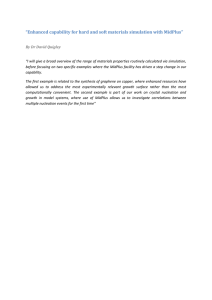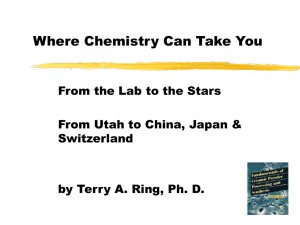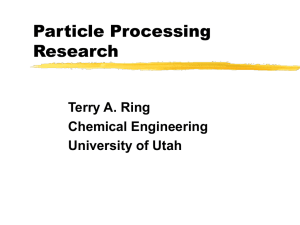Where Chemistry Can Take You From the lab to the Stars Switzerland
advertisement
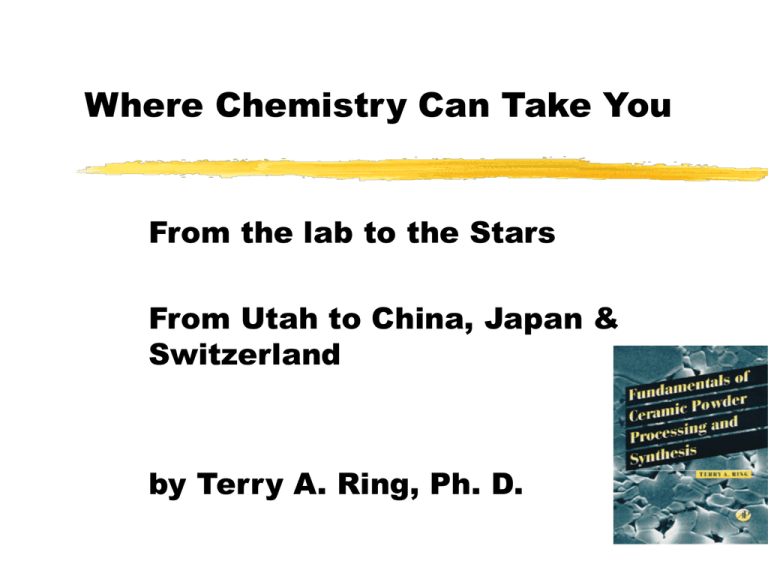
Where Chemistry Can Take You From the lab to the Stars From Utah to China, Japan & Switzerland by Terry A. Ring, Ph. D. Davis High Chemistry Earning a Living with Chemistry Talk about some of my research Making Powders by Crystallization[= Precipitation] Nucleation Crystal Growth Making Nano Particles Nano Particles = Big Surprises Demonstration Clock Reaction Ring’s Chemistry Competition Go to College and Get an Education Why do your parents keep saying that? Education Pays What do you want to be when you grow up? Many possibilities to use your scientific education! Biologist Chemist Physicist Engineer Mathematician Teacher Doctor Lawyer YOUR DECISION HAS CONSEQUENCES! $$$$$$ How Much Do You Want to Earn When You Grow up? Job Growth Chemistry Job Growth rate is ~14%/10 yr Do the Popular Professions Pay Well? Which Job Pays More? Computer Engineer? Biologist? Chemist? Chemical Engineer? Salary Information Chem. Eng. Median Salary for B.S. =$62,000/yr Starting Salary ~$54,000/yr Starting Salary Crystalization Research CuNO3 + NaC2O4 CuC2O4.xH2O Additives Control of Particle Shape Epitaxial Aggregation Mixing - 1μs to 10 ms Nucleation - 10μs or mixing time Growth - 10μs or mixing time Aggregation - 10 ms Self Assembly - 10 ms Hexagonal Packing of Spheres Light Diffraction Defects in Ordered Arrays Bend Light Optical Semiconductors Photonic Crystal Light Pipe Light Pipe Light Leaving Pipe Nano-sized Cluster Nucleation Terry A. Ring Chemical Engineering University of Utah Introduction Classical Nucleation Theory & Limitations New Theory & Findings The Nanoscale is small! Conventional Machines (m - mm) Microelectronics (micron = 10-6 m) (10 cm down to 0.1 µm) Nanotechnology nanometer= 10-9 m (100 nm to 1 nm) Silicon Particles Introduction Unique Properties of Nanosized Particles Plasmon Resonance -color due to size, color change due to adsorption-sensors Between Bulk and Atomic Electrical Properties Catalytic Properties Magic Cluster Sizes C60, C70, C nanotubes, Na clusters of 8, 20, 40, 58 and 92 Stimulated Emission CdS Nano-Clusters-Laser Lasing only when quantum dot concentration is sufficiently high. Stimulated emission>Auger recombination Klimov, V. Mikhailovsky, A.,Xu, S., Hollingswork, J., Malko, A., Bawendi, M., Eiser, H-J., Leatherhead, C.A. Science 290,314 (2000) Science 287,1011 (2000) Fullerene Synthesis Not Predicted By Theory! Nanoparticle Synthesis = Nucleation • Classical Nucleation Theory vs New Theory – Binding Energy per Li atom Kouteckky, J. and Fantucci, P., Chem. Rev., 86,539-87(1986). 18.3358 ( GS ) is 2 3 2 4 . . a1 . . ig kB . T ig 1 0 . ig -0 0 1 10 is , ig 20 20 G(i) = - i kBT lnS + ba ao2 i2/3 Population Balances Classical Nucleation = Single Atom Addition Ck / t lij=(i+j), 1 l1,k 1C1Ck 1 l1,k Ck C1 2 Population Balance - Multi-atom Addition k 1 i 1 i 1 Ck / t 1/ 2 li,k iCiCk i Ck li,k Ci lij=(i+j)exp(-DGij/kBT), Quantum Mech. 1 C 1 C m, 1 m, 1 N( m. Dt , 1 ) 0.5 C m, 2 N( m. Dt , 1 ) 0.5 C m, 2 N( m. Dt , 2 ) N( m. Dt , 2 ) 0 0 1 10 6 2 10 m. D t 6 6 3 10 0.9999 N C tmax . Dt , k 2 tmax ,k 2 N( tmax . Dt , k ) C Classical tmax , k 4.63056e-33 0 1 2 3 4 5 6 7 8 910 k 9 0 1 0.1 0.01 tmax . 0.001 Dt , k 4 2 1 10 5 1 10 6 tmax 1 10 ,k 7 1 10 2 8 1 10 ( tmax . Dt , k ) 1 10 9 10 1 10 11 tmax , k 1 10 12 1 10 13 1 10 14 1 10 0 0.05 m. D t 0.1 1 0 1 2 3 4 5 6 7 8 910 k Population Comparison New Theory of Nucleation Overcomes Limitations of Classical Nucleation Theory Multi-atom addition Free Energy driving force for Diffusion and Addition Predicts Transients for Cluster Concentration of Each Size Qualitative similar to Si Plasma Expts Collision Energetics 0.8 o BE/ n (eV) BE (i+j) 0.6 o BE + BE i j ²E Crystallolumines cen ce 0.4 o EA BE *+ BE* i j 0.2 0 0 2 Collision Trajectory, R/r Figure 3 Collision trajectory for collision between i=3 and j=4 clusters, showing ground state energies before and after collision, as well as the activiation energy of collsion. 4 e Crystalloluminesent Spectrum Intensity vs Energy Intensity = 0.1 0.01 0.001 collisions/per unit time = photons/unit time Wavelength E = hc/l 1 10 1 10 1 10 I i, k 1 10 1 10 1 10 1 10 1 10 Human eye detection 3x104photons/cm2/s @ λ 510 nm at 1 10 1 10 1 10 4 5 6 7 8 9 10 11 12 13 14 0 0.5 1 1.5 DE i, k eV 2 2.5 Similar to Line Spectra Crystalloluminescence • Term Schoenwald in 1786 30 References 1786 and 1957 • “An understanding of crystalloluminescence in not to satisfactory at the present time,” E.N. Harvey 1957 Examples: NaCl, KCl, NaF, AsCl3, K2SO4, As3O3, Sr(NO3)2,, CoSO4, K2CO3, KHSO3, NaKSO4, NaKCrO4, NaKSeO4, Na2SO4, benzoic acid, and ice, water. 16 References 1957-1991 (15 Russian+ 1 UK + 1 Italian Review) “It is not possible to … provide either a unifying physical picture of the microscopic mechanism governing (crystalloluminescence) or a physical rule that allows (identification conditions...where the phenomenon is stronger,” Barsanti, M. & Maccarrone,,F., 1991 3 References from 1991-2000 (2 India, 1 Russian) of) Experimental Observations Delay time is a function of concentration & mixing Flashes are Short < 80 ns Saturated NaCl + Conc. HCl - 120 s observation time Peak Count rates ~5-8x105 photons/s Gibbon, M.A., Sopp, H. , Swanson, J., and Walton, A.J., J. Phys. C. 21,1921(1988). Temporal & Spatial Bunching of Flashes 340nm<λ<380 nm Blue White Light Spectrum of Light NaCl Crystallization Data from dr KRZYSZTOF KLEDZIK University of Gdansk Spectra Has Series of Peaks Different from Thermal Luminescence Photoluminescence Impurities in Crystal have a Big Effect Spectrum Rabinerson, A.I. Wladimirskaya, M.A., Acta Physicochimica URSS, 10,859(1939) Makes New Predictions Explains the reason for the occurrence of Magic Clusters and how the change with time. Method to Quantitatively Measure Nucleation Events Predicts Crystalloluminescent Spectrum Where could we see Crystalloluminescence? H2O Condensation Nucleation Interstellar Dust Nucleation Light from Deep Sea Vents Water Condensation due to Shock Wave Interstellar Dust Clouds - Light from the Fringe - Crystalloluminescence due to Nanocluster Nucleation Experimental Verification Nanocluster, Ti14C13 with emission peak at 20.1 microns is seen in Egg Nebula by A.G.G.M. Thielens and M.A. Duncan Science 288,313(2000) this joins some 120 other small molecules identified in the vicinity of stars, interstellar gas and dust clouds Super Novae Deep Sea Vents National Geographic October 2000 C&E News 12/21/98 Deep Sea Life Salt Lake Tribune, 2/13/97 National Geographic October 2000 Deep Sea Vents Deep Sea Vents Spew Solublized Salts into the cold sea, causing Precipitation & Crystalloluminescence In the Deep Ocean, Deep Sea Vents are the only source of Chemical Energy and Food Mobile Animals need to be able to locate these Vents to eat - so they need eyes!! EAT AT JOE’S Once in a while you get shown the light….. In the strangest places but only if you look at it right. Clock Reaction The first step in this reaction is the formation of triiodide ion: H2O2 + 3 I- + 2 H+ --> I3- + 2 HO In the absence of thiosulfate ion the triiodide ion would form the characteristic blue complex with starch. However, the triiodide ion is rapidly reduced back to iodide ion by thiosulfate: I3- + 2 S2O32- --> 3 I- + S4O62 In this clock reaction thiosulfate ion is the limiting reactant. The blue starch-triiodide complex forms only when all the thiosulfate ion has been consumed. IO3- + 2 H2O2 + H+ = HOI + 2 O2 + 2 H2O (A) HOI + CH2(CO2H)2 = ICH(CO2H)2 + H2O (B)
